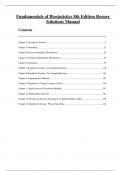Exam (elaborations)
Complete Solution Manual Fundamentals of Biostatistics 8th Edition Rosner Questions & Answers with rationales
- Course
- Institution
- Book
Fundamentals of Biostatistics 8th Edition Rosner Solutions Manual Complete Solution Manual Fundamentals of Biostatistics 8th Edition Rosner Questions & Answers with rationales PDF File All Pages All Chapters Grade A+
[Show more]



